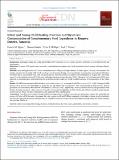Infant and Young Child Feeding Practices and Mycotoxin Contamination of Complementary Food Ingredients in Kongwa District, Tanzania

View/
Date
2023-02Author
Ngure, Francis
Kassim, Neema
Phillips, Erica
Turner, Paul
Metadata
Show full item recordAbstract
Background: Inadequate infant and young child feeding (IYCF) practices in low income countries contribute to poor child growth and
development.
Objectives: To assess IYCF practices and mycotoxin contamination in complementary food ingredients across 2 seasons in Kongwa District,
Tanzania.
Methods: Early feeding practices in 115 rural households from 25 villages in Kongwa District, Dodoma region, Tanzania, were assessed. The
primary caregiver for the index child (6–18 mo of age) was interviewed using a structured dietary questionnaire at recruitment (October/
November 2017), and revisited 6 mo later. The questionnaire included questions on typical food consumption in the past 24 h. This study
reports 7 of the revised and new IYCF indicators, including minimum dietary diversity (MDD). Aflatoxins (AF) and fumonisins (FUM) were
analyzed in complementary food ingredients for pooled household samples to broadly establish patterns of contamination at the village
level.
Results: The MDD was not met for 80% of infants at recruitment (survey 1) as compared with 56% in survey 2 (P < 0.05). Changes in MDD
between the 2 surveys were dependent on season but not age. Maize was consumed by >90% of households in both surveys, whereas
groundnut was consumed by 44% and 64% of households in surveys 1 and 2, respectively. AF concentrations in maize and groundnuts were
found to be higher in survey 1 than in survey 2. Overall, AF exceeded the legal limit in 18% of maize and 61% of groundnut pooled samples
in both surveys. Maize was also contaminated with significant FUM concentrations.
Conclusions: Poor diets were common among children in Kongwa District. Reliance on maize and groundnuts exposes this vulnerable age
group to AF (also to FUM in maize). Inadequate diet and exposure to AF and FUM have separately been linked to linear growth retardation.
Low diet diversity and mycotoxins contamination are plausible causes for poor growth and development among infants in Central Tanzania.
Curr Dev Nutr 20XX;x:xx
URI
https://doi.org/10.1016/j.cdnut.2023.100030https://dspace.nm-aist.ac.tz/handle/20.500.12479/2089
